Fuel vehicles are accelerating their withdrawal, and you may have nowhere to refuel in 5 years
![]() 09/19 2024
09/19 2024
![]() 432
432
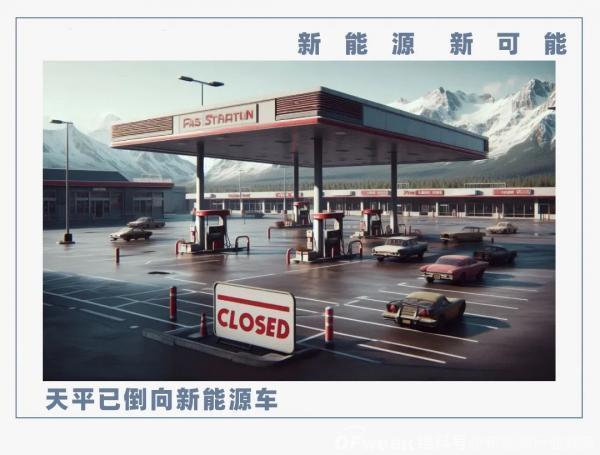
Original by New Energy View (ID: xinnengyuanqianzhan)
Are there more and more green license plate cars around you? This is supported by data.
According to the latest retail sales statistics from the China Passenger Car Association's Passenger Car Market Information Joint Council (CPCA), in August, 1.905 million narrow-sense passenger cars (sedans, MPVs, SUVs) were sold retail nationwide, of which conventional fuel vehicles declined by 28% year-on-year, while new energy vehicles increased by 43.2% year-on-year. The retail penetration rate of new energy vehicles rose to 53.9%, setting a new high.
It's like a seesaw game where if one side gets crowded, the other side becomes empty. The gap widens as one side gains and the other loses.
As new energy vehicle sales continue to climb and market penetration rates set new records, the withdrawal of fuel vehicles is happening much faster than we anticipated.
When buying a car, new energy vehicles are inevitably becoming a must-consider option. So, are you ready to 'plug in'?
1. The General Trend: New Energy Vehicle Penetration Rate Exceeds 50% for Two Consecutive Months
As an ordinary consumer, if you haven't yet grasped the current trend in the automotive market, let's start with three key figures:
June: 48.4%; July: 51.5%; August: 53.9%.
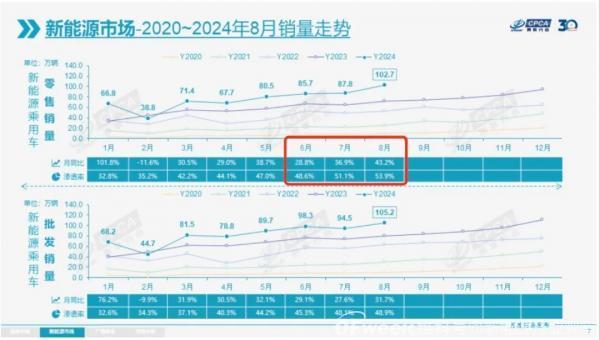
Chart/Trend of the New Energy Vehicle Market from June to August 2024
Source/CPCA New Energy View Screenshot
This shows the changes in the retail penetration rate of the domestic new energy vehicle market over the past three months.
The retail penetration rate refers to the proportion of new energy vehicles in the overall automotive retail market. For example, the 53.9% figure in August means that out of every 1,000 vehicles sold in the retail market that month, 539 were new energy vehicles, indicating that new energy vehicles now account for a larger share of retail sales than traditional fuel vehicles.
If you still have prejudices against new energy vehicles, the market has already told us that whether pure electric or hybrid, electric cars are now selling better.
From exceeding 50% for the first time in July to maintaining this level for two consecutive months in August, new energy vehicles have continued to expand their share in the automotive consumer market, posing a formidable challenge to traditional fuel vehicles.
From first-tier cities to remote villages, green license plate new energy vehicles are increasingly visible in our daily lives.
Let's continue with the data.
According to the latest statistics from the CPCA, in the new energy passenger car segment, 6.572 million vehicles were produced from January to August 2024, an increase of 28.5% year-on-year; wholesale sales reached 6.622 million, up 30.2% year-on-year; and retail sales hit 6.016 million, up 35.3% year-on-year.
Specifically, in August, 1.051 million vehicles were produced, up 32.6% year-on-year; wholesale sales reached 1.052 million, up 31.7% year-on-year; and retail sales hit 1.027 million, up 43.2% year-on-year.

Chart/August 2024 Production, Retail, and Wholesale Data
Source/CPCA New Energy View Screenshot
Whether it's production, wholesale, or retail, the numbers speak for themselves with a significant increase across the board.
Industry insiders generally attribute this growth to the further implementation of scrappage and trade-in policies, as well as the stabilization of terminal prices following the government's call for anti-competition. This has alleviated consumer wait-and-see attitudes and boosted overall market enthusiasm.
How can ordinary consumers understand the reasons behind this? There are two main factors involved:
First, policy factors, including scrappage and trade-in policies. The 17% month-on-month growth in new energy vehicle retail sales in August reflects the positive market response to the national scrappage policy. As of 10 AM on August 31, over 800,000 applications for scrappage subsidies had been received. This translates to over 13,300 new scrappage applications per day in the second half of August, demonstrating the effectiveness of the scrappage policy.
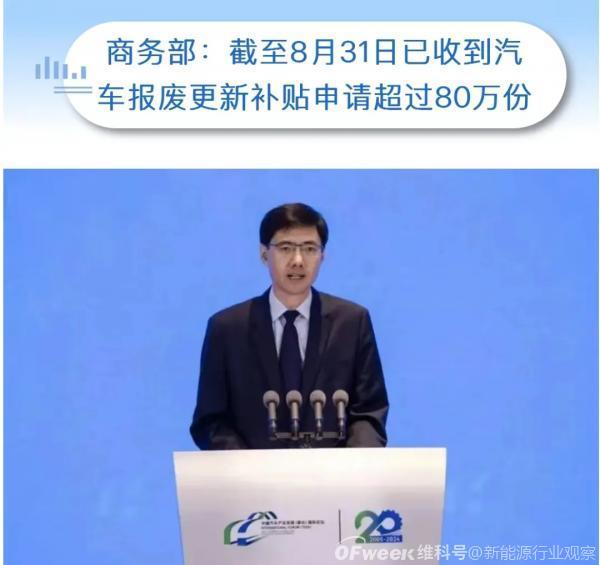
Chart/Over 800,000 Scrappage Subsidy Applications Received as of August 31
Source/Internet New Energy View Screenshot
Second, price factors. In response to the government's call for anti-competition, price wars among automakers have eased, and price fluctuations have narrowed. Consumers who were waiting for significant price drops have found that prices have stabilized, prompting them to make purchases. This uptick in retail sales is immediately reflected in automakers' sales reports.
Various signs in the retail market indicate that new energy vehicles will continue to gain momentum and capture more market share from fuel vehicles.
This aligns with the predictions of industry leaders. Elon Musk, CEO of Tesla, has repeatedly stated that new energy vehicles will eventually replace fuel vehicles as the mainstream mode of transportation. Li Xiang, founder of NIO, also believes that the new energy automobile industry represents a strategic emerging industry with enormous development potential.
2. Love and Fear: Consumers' Perceptions of New Energy Vehicles
If you were to buy a car, would you choose a new energy vehicle? Do you still have reservations?
This is normal, especially for consumers who have never owned a new energy vehicle before. Who knows if they're reliable?
We spoke to a dozen fuel vehicle owners and summarized some representative views:
Owner A: I've been driving my fuel car for ten years. Although it has high fuel consumption, lackluster acceleration, an outdated design, and no smart features, its engine and transmission are durable and have never left me stranded on the road.
Owner B: New energy vehicles do save money on fuel, but I've heard that many of them can't travel far or on highways, and their batteries degrade quickly, leading to frequent power loss.
Owner C: Electric cars are great, but charging is slow, and there aren't as many charging stations as gas stations. I've also heard about electric cars catching fire, which is terrifying!
Many consumers who are buying their first car or replacing an old one hold both anticipation and reservations about new energy vehicles.
In reality, this reflects a cognitive iteration process that requires a developmental perspective. Some of these concerns are outdated or based on misunderstandings.
People tend to be critical of new things. For example, air crashes are rare but receive global attention when they occur. Similarly, when a new energy vehicle catches fire, the news spreads rapidly.
From January to August 2024, 6.016 million new energy vehicles were sold in the retail market, with only a negligible number of vehicles experiencing spontaneous combustion. While some may argue that even a one-in-a-thousand or one-in-ten-thousand chance is a hundred percent risk for them personally, it's important to consider another fact that challenges common perceptions: fuel vehicles have a much higher risk of spontaneous combustion than new energy vehicles.
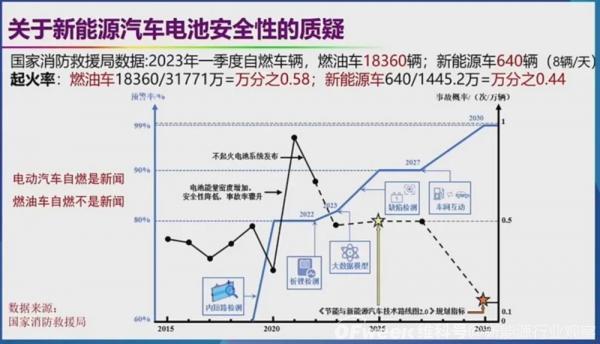
Chart/Fuel Vehicle vs. New Energy Vehicle Fire Rates
Source/National Fire and Rescue Administration New Energy View Screenshot
Fuel vehicle fires are often caused by various factors, including electrical system malfunctions, fuel leaks, engine overheating, and improper modifications. These factors are more likely to trigger fires in older vehicles or those poorly maintained. The complexity and flammability of the fuel system increase the risk of fire accidents.
In contrast, new energy vehicles, especially pure electric vehicles, are designed with fire safety in mind. Electric vehicles don't have internal combustion engines, eliminating the risk of fuel leaks. They are equipped with advanced battery management systems (BMS) that monitor battery status in real-time and take necessary safety measures to prevent overheating or other fire hazards.
New energy vehicles must meet stricter fire safety standards before production and sale, including battery pack design, crash protection, and emergency response guidelines. These measures help reduce the risk of electric vehicle fires.
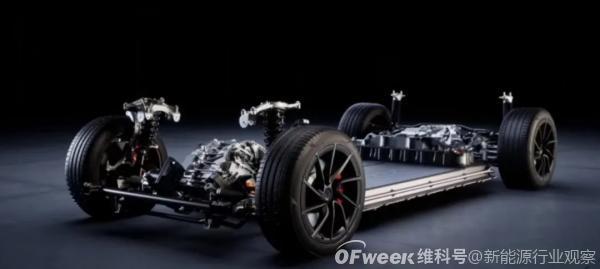
Chart/Integrated Body Structure of Tesla
Source/Internet New Energy View Screenshot
While there are more fuel vehicle fires in absolute numbers, any news related to the safety of new energy vehicles tends to attract more attention due to their relatively new status. This can create a misperception that new energy vehicles are more prone to fires.
Objectively speaking, any type of vehicle has the potential for spontaneous combustion, but based on current data and case studies, fuel vehicles generally have a higher risk of fire than new energy vehicles. Proper use and regular maintenance are crucial for ensuring driving safety, regardless of vehicle type.
This is not an endorsement of new energy vehicles but a statement based on objective facts. With continuous advancements in automotive battery technology and the improvement of charging infrastructure, issues related to driving range and charging convenience in new energy vehicles will gradually be resolved. Meanwhile, the application of cutting-edge technologies such as intelligence and connectivity will further enhance the competitiveness and user experience of new energy vehicles.
3. You Might Not Find a Gas Station in 5 Years
Mr. Ding from Shandong was initially dismissive of new energy vehicles. After driving a fuel car for seven or eight years, he went to a 4S dealership to look for a replacement fuel car. While there, he stumbled upon a Tesla experience center next door and decided to take a look.
Not only did he look, but he also took a test drive.
'It's fast! It just zooms out!' Mr. Ding remarked that his first impression was that it drove better than a fuel car. Although he wasn't yet accustomed to Tesla's accelerator design, after two laps, he experienced the power and smoothness of a new energy vehicle.
After returning home, he embarked on a journey of learning about Tesla. The more he read, the more he liked it. Eventually, his perception flipped 180 degrees. He went back to the Tesla dealership, combined his online research with an offline test drive, and made up his mind to purchase a Model Y.
The future is already here, and the cost-effectiveness of new energy vehicles is on the rise as product lines continue to expand. XPeng's MONA M03, for example, starts at just RMB 119,800, and there are even electric cars priced below RMB 100,000. Aren't these options attractive?
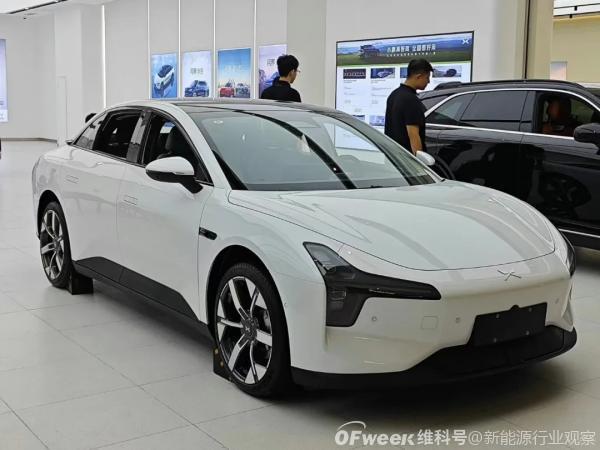
Chart/XPeng MONA M03
Source/Photo by New Energy View
'I ordered my car immediately after Nezha announced the price drop. I wasn't planning to buy an electric car, but more and more of my friends were switching, and they all said it was great. So, I went along with it,' said Sun Ning (pseudonym), who was originally set on buying a fuel car for his upcoming wedding this National Day holiday. After much deliberation, he had decided on a Toyota fuel car but was swayed by the significant price drop in electric cars and ultimately made the switch.
Such reversals and changes of heart are common in real life. This is the general trend. Although new energy vehicles and their supporting infrastructure still have issues, the mainstream direction is forward, representing advanced productivity. These minor issues will naturally be resolved in the course of development.
Take the issue of charging stations mentioned earlier. The market is the guiding force for resource allocation. With so many new energy vehicles needing to be charged, investors are not foolish and will naturally heat up and invigorate the charging station market.
According to news reports, to support the promotion and use of new energy vehicles, regions across the country are accelerating the construction of a comprehensive charging infrastructure system. It is expected that by the end of the 14th Five-Year Plan period, a widely covered, reasonably distributed, and fully functional charging service network will be established nationwide.

Chart/China's Electric Vehicle Charging Infrastructure Plan
Source/Extreme News New Energy View Screenshot
Perhaps in the next five years, as more and more people opt for new energy vehicles and fewer choose fuel vehicles, charging stations will gradually gain the upper hand in the battle against gas stations. Under the influence of market conditions, the fortunes may shift, leading to the closure or transformation of gas stations, making them harder to find.
In fact, in recent years, government departments at all levels have successively introduced a series of incentive policies, including purchase subsidies, exemption from purchase taxes, and priority right of way, significantly lowering the threshold for purchasing new energy vehicles.
Looking ahead, the new energy vehicle market will continue to expand with a richer product line. Consumers expect new energy vehicles to make greater breakthroughs in driving range, charging speed, and intelligence, providing more options for green travel. Whether in a wait-and-see attitude or eager to embrace change, every consumer should actively participate in this transformation and work together to create a greener and smarter future of mobility.








